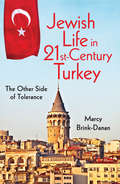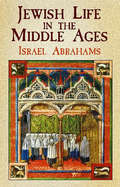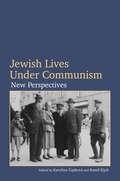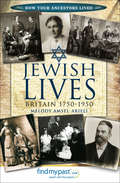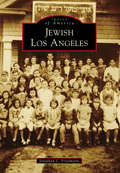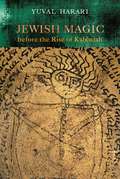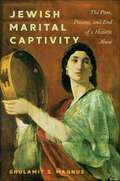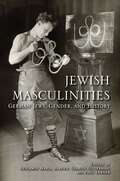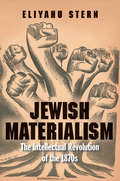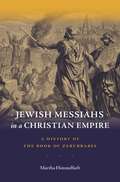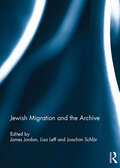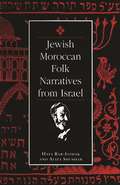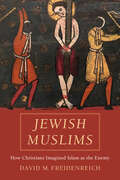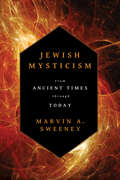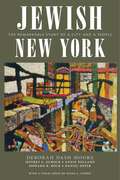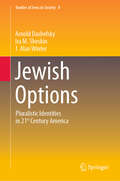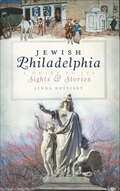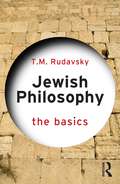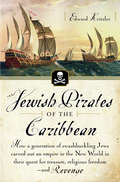- Table View
- List View
Jewish Life in Twenty-First-Century Turkey
by Marcy Brink-DananTurkey is famed for a history of tolerance toward minorities, and there is a growing nostalgia for the "Ottoman mosaic." In this richly detailed study, Marcy Brink-Danan examines what it means for Jews to live as a tolerated minority in contemporary Istanbul. Often portrayed as the "good minority," Jews in Turkey celebrate their long history in the region, yet they are subject to discrimination and their institutions are regularly threatened and periodically attacked. Brink-Danan explores the contradictions and gaps in the popular ideology of Turkey as a land of tolerance, describing how Turkish Jews manage the tensions between cosmopolitanism and patriotism, difference as Jews and sameness as Turkish citizens, tolerance and violence.
Jewish Life in the Middle Ages
by Israel AbrahamsHighly readable social history comprehensively examines life of European Jews, from approximately the late 10th-century to the early 1500s. Topics include social functions of the synagogue, communal organizations, love, courtship and marriage, monogamy and home life, trades and occupations, medieval pastimes and personal relations between Christians and Jews.
Jewish Lives Under Communism: New Perspectives
by David Shneer Gennady Estraikh Anna Shternshis Diana Dumitru Katerina Capková Kamil Kijek Stephan Stach Valery Dymshits Anna Koch Agata Maksimowska Marcos Silber Galina Zelenina Kata BohusThis volume provides new, groundbreaking views of Jewish life in various countries of the pro-Soviet bloc from the end of the Second World War until the collapse of Communism in late 1989. The authors, twelve leading historians and anthropologists from Europe, Israel and the United States, look at the experience of Jews under Communism by digging beyond formal state policy and instead examining the ways in which Jews creatively seized opportunities to develop and express their identities, religious and secular, even under great duress. The volume shifts the focus from Jews being objects of Communist state policy (and from anti-Jewish prejudices in Communist societies) to the agency of Jews and their creativity in Communist Europe after the Holocaust. The examination of Jewish history from a transnational vantage point challenges a dominant strand in history writing today, by showing instead the wide variety of Jewish experiences in law, traditions and institutional frameworks as conceived from one Communist country to another and even within a single country, such as Poland, Czechoslovakia, Hungary, East Germany, and the Soviet Union. By focusing on networks across east-central Europe and beyond and on the forms of identity open to Jews in this important period, the volume begins a crucial rethinking of social and cultural life under Communist regimes.
Jewish Lives: Britain 1750–1950 (How Your Ancestors Lived)
by Melody Amsel-Arieli&“Offers a guide to family historians who want to reconstruct their family trees. Invaluable . . . to other Jews in search of their roots&” (Jewish Renaissance). Jewish Lives presents the life-stories of ten individual Jews who immigrated to Britain between 1750 and 1950, based on actual genealogical research. Their stories, enriched by a variety of sources, reflect the experiences of all Jewish immigrants as they settled in their adopted land. Melody Amsel-Arieli does not just piece together the detail of their lives—their work, pastimes, families, daily chores, food, and celebrations. Drawing on social, economic, and historical records, she also explores their background, places of origin, motives for immigration, arrival in the United Kingdom, and experiences as they adjusted to their new surroundings—placing them in the wider historical context of their adopted community and society. This selection of revealing life-stories will prove fascinating for family historians and researchers, Jewish and non-Jewish alike, by offering parallels with their own lives and the lives of their ancestors. Jewish Lives: Britain 1750–1950 will inspire readers to pursue their own quest for information and understanding of their pasts. &“Each tale is based on research shared by a descendent, so sources very from official documents to diaries and memories, adding a rich, personal dimension.&” —Family Tree &“Melody Amsel-Arieli is a prolific writer on matters genealogical and historical, but in this book her expertise in both fields shines out. For anyone researching his or her own immigrant family, Jewish Lives really is a must-read.&” —Who Do You Think You Are?
Jewish Los Angeles: Jewish Musicians In Los Angeles, 1887-1927 (Images of America)
by Jonathan L. FriedmannThe first known Jewish resident of the Mexican Pueblo de Los Ángeles arrived in 1841. When California entered the Union in 1850, the census listed just eight Jews living in Los Angeles. By 1855, the fledgling city had a Hebrew Benevolent Society and a Jewish cemetery. The first Jewish congregation and kosher market were established in 1862. Meanwhile, Jewish merchants and business owners founded banks, fraternal orders, charities, athletic clubs, and social service organizations. Jewish property owners developed vast areas of Los Angeles and beyond into the neighborhoods and cities we know today. By 1897, the city's Jewish population was large enough to support its own newspaper. The 20th century brought waves of Jewish immigrants and migrants to Los Angeles, where they built the motion picture and television industries, Cedars-Sinai and City of Hope medical centers, the Jewish Home for the Aging, urban and suburban synagogues and Jewish centers, and other institutions. The foundations laid by these enterprising pioneers helped transform Los Angeles into a major metropolis.
Jewish Magic before the Rise of Kabbalah (Raphael Patai Series in Jewish Folklore and Anthropology)
by Yuval Harari“Magic culture is certainly fascinating. But what is it? What, in fact, are magic writings, magic artifacts?” Originally published in Hebrew in 2010, Jewish Magic Before the Rise of Kabbalah is a comprehensive study of early Jewish magic focusing on three major topics: Jewish magic inventiveness, the conflict with the culture it reflects, and the scientific study of both. The first part of the book analyzes the essence of magic in general and Jewish magic in particular. The book begins with theories addressing the relationship of magic and religion in fields like comparative study of religion, sociology of religion, history, and cultural anthropology, and considers the implications of the paradigm shift in the interdisciplinary understanding of magic for the study of Jewish magic. The second part of the book focuses on Jewish magic culture in late antiquity and in the early Islamic period. This section highlights the artifacts left behind by the magic practitioners—amulets, bowls, precious stones, and human skulls—as well as manuals that include hundreds of recipes. Jewish Magic before the Rise of Kabbalah also reports on the culture that is reflected in the magic evidence from the perspective of external non-magic contemporary Jewish sources. Issues of magic and religion, magical mysticism, and magic and social power are dealt with in length in this thorough investigation. Scholars interested in early Jewish history and comparative religions will find great value in this text.
Jewish Marital Captivity: The Past, Present, and End of a Historic Abuse
by Shulamit S. MagnusSolutions to divorce abuse in Jewish societiesJewish Marital Captivity centers on the experience of women encountering systemic disadvantage in rabbinic marriage and divorce throughout Jewish history and across the map of Jewish life. In rabbinic law, marriage is a unilateral act by the husband, making divorce, similarly, the husband’s sole prerogative, in which his conscious will is also sacrosanct. Abuse necessarily follows, and has been the case from earliest recorded history when husbands abandoned wives, perished on business trips or in war or criminal incidents, or maliciously refused wives a rabbinic writ of divorce (get), or extorted for one, leaving wives trapped in marriage, including to dead men. There is no time limit to this state. Women in such marital captivity, without a husband’s economic partnership, or divorce or death settlements, yet unfree to contract other marriages, suffered devastating social, economic, and psychological hardship, as did their children. Women’s marital captivity has been treated as an issue in rabbinic law but has not, until now, been studied as a problem in Jewish societies across time and place, with a focus on the predicament and behavior of women.Jewish Marital Captivity is a social history of this problem from the seventh century to the present across multiple Jewish communities, focusing on the interaction of law and social reality. Magnus documents a pattern of assertive and transgressive actions by pious and rebellious women in traditional Jewish societies to escape marital captivity, often, with the assistance of male kin, also probing why such behavior emerged in pre-modern, patriarchal societies. She charts women’s role in the emergence of reforms in the medieval era offering women significant protections in marriage and divorce, and rabbinic backlash against these advances. This backlash was codified and its legal rulings are enacted to this day in rabbinic courts in the US and other Diaspora communities and in Israel, which lacks civil marriage and divorce and where Jewish citizens can only get divorced in rabbinic courts. It combines a sweeping history of Jewish women’s marital captivity with an analysis of the problem’s systemic nature, however personally and individually women experience it, and with a critique of current policy as seeking to manage and thus, perpetuate, rather than end the abuse. It applies the lessons of the history uncovered to propose solutions to what Magnus presents not as an Orthodox or an Israeli problem, but a Jewish one.
Jewish Masculinities: German Jews, Gender, and History
by Benjamin Maria Baader, Sharon Gillerman, and Paul LernerStudies exploring the history of the German-Jewish male identity from the sixteenth to twentieth centuries, across a myriad of societal occupations.Stereotyped as delicate and feeble intellectuals, Jewish men in German-speaking lands in fact developed a rich and complex spectrum of male norms, models, and behaviors. Jewish Masculinities explores conceptions and experiences of masculinity among Jews in Germany from the sixteenth through the late twentieth century as well as emigrants to North America, Palestine, and Israel. The volume examines the different worlds of students, businessmen, mohels, ritual slaughterers, rabbis, performers, and others, shedding new light on the challenge for Jewish men of balancing German citizenship and cultural affiliation with Jewish communal solidarity, religious practice, and identity.“A valuable addition to the growing field of Jewish gender history.” —Derek Penslar, University of Toronto“[This book] assembles innovative, vivid, and inspiring inquiries into the intersection of Jewish history, German history, and gender history. By focusing on the male side of Jewish gender history . . . [this] book establishes a new field, profiting from a broad range of never (or rarely) before used primary sources, such as memoirs, letters, interviews, and obscure tabloids.” —German Studies Review, May 2014“[A]n excellent introduction to the Zionist remasculinization of the Jewish male.” —H-Judaic, February 2015“[I]nsightful, innovative and largely entertaining. . . . [T]his volume makes a very valuable and original contribution to German-Jewish history.” —German History“Historians of central Europe will be enriched by the interrogations of “theory” along with excavations of little-known yet critical avenues of Jewish history in this excellent volume.” —Central European History
Jewish Materialism: The Intellectual Revolution of the 1870s
by Eliyahu SternA paradigm-shifting account of the modern Jewish experience, from one of the most creative young historians of his generationTo understand the organizing framework of modern Judaism, Eliyahu Stern believes that we should look deeper and farther than the Holocaust, the establishment of the State of Israel, and the influence and affluence of American Jewry. Against the revolutionary backdrop of mid-nineteenth-century Europe, Stern unearths the path that led a group of rabbis, scientists, communal leaders, and political upstarts to reconstruct the core tenets of Judaism and join the vanguard of twentieth-century revolutionary politics. In the face of dire poverty and rampant anti-Semitism, they mobilized Judaism for projects directed at ensuring the fair and equal distribution of resources in society. Their program drew as much from the universalism of Karl Marx and Charles Darwin as from the messianism and utopianism of biblical and Kabbalistic works. Once described as a religion consisting of rituals, reason, and rabbinics, Judaism was now also rooted in land, labor, and bodies. Exhaustively researched, this original, revisionist account challenges our standard narratives of nationalism, secularization, and de-Judaization.
Jewish Messiahs in a Christian Empire: A History of the Book of Zerubbabel
by Martha HimmelfarbThe seventh-century CE Hebrew work Sefer Zerubbabel (Book of Zerubbabel)—a tale of two messiahs—is the first full-fledged messianic narrative in Jewish literature. Martha Himmelfarb offers a comprehensive analysis of this rich understudied text, illuminating its distinctive literary features and the complex milieu from which it arose.
Jewish Miami Beach (Images of America)
by Paul S. George Henry A. GreenFrom a disregarded, forlorn island in the early 1900s to the world-famous resort and go-to place of today, Jews have played a prominent role in Miami Beach's achievements and fame. Initially consigned to a tiny enclave on the southern tip of Miami Beach, the community's Jewish population quickly expanded north, from South Beach to Golden Beach, and assumed a leadership position in nearly every phase of the city's life by the late 1900s. At every step of Miami Beach's rich history--from commerce, architecture, and banking to hospitality, real estate, and government--the Jewish community blossomed, enabling Jews to play singular roles in a drama that continues to unfold.
Jewish Migration and the Archive
by James Jordan, Lisa Leff and Joachim SchlörMigration is, and has always been, a disruptive experience. Freedom from oppression and hope for a better life are counter-balanced by feelings of loss – loss of family members, of a home, of personal belongings. Memories of the migration process itself often fade quickly away in view of the new challenges that await immigrants in their new homelands. This volume asks, and shows, how migration memories have been kept, stored, forgotten, and indeed retrieved in many different archives, in official institutions, in heritage centres, as well as in personal and family collections. Based on a variety of examples and conceptual approaches – from artistic approaches to the family archive via ‘smell and memory as archives’, to a cultural history of the suitcase – this volume offers a new and original way to write Jewish history and the history of Jewish migration in the context of personal and public memory. The documents reflect the transitory character of the migration experience, and they tell stories of longing and belonging. This book was originally published as a special issue of Jewish Culture and History.
Jewish Moroccan Folk Narratives from Israel (Raphael Patai Series in Jewish Folklore and Anthropology)
by Haya Bar-Itzhak Aliza ShenharJewish Moroccan Folk Narratives focuses on two central elements: textual research to examine the aesthetic qualities of the narrative, their division into genres, the various versions and their parallels, and acculturation in Israel, as well as contextual research to examine the performance art of the narrator and the role of the narrative as a communicative process in the narrating society. The collection includes twenty-one narratives by twelve storytellers; an account of the narrators' lives and a commentary have been applied to each. In contrast to most anthologies of Jewish folktales, the texts in this book were recorded in the natural context of narration and in the language of origin (Judaeo-Arabic), meeting the most vigorous standards of current folklore scholarship.
Jewish Muslims: How Christians Imagined Islam as the Enemy
by David M. FreidenreichUncovering the hidden history of Islamophobia and its surprising connections to the long-standing hatred of Jews. Hatred of Jews and hatred of Muslims have been intertwined in Christian thought since the rise of Islam. In Jewish Muslims, David M. Freidenreich explores the history of this complex, perplexing, and emotionally fraught phenomenon. He makes the compelling case that, then and now, hate-mongers target "them" in an effort to define "us." Analyzing anti-Muslim sentiment in texts and images produced across Europe and the Middle East over a thousand years, the author shows how Christians intentionally distorted reality by alleging that Muslims were just like Jews. They did so not only to justify assaults against Muslims on theological grounds but also to motivate fellow believers to live as "good" Christians. The disdain premodern polemicists expressed for Islam and Judaism was never really about these religions. Rather, they sought to promote their own visions of Christianity—a dynamic that similarly animates portrayals of Muslims and Jews today.
Jewish Mysticism and Kabbalah: New Insights and Scholarship (Jewish Studies in the 21st Century #2)
by Frederick E GreenspahnInformative and accessible essays exploring contemporary scholarship in Jewish mysticism and Kabbalah.“This carefully edited collection of essays on Jewish mysticism effectively delivers on its promise to be accessible to broad audiences. The volume amounts to a thoughtful and lucid conversation among leading scholars. . . . The literate lay reader as well as faculty and students in a wide range of university courses will find this to be a most useful gateway to Jewish mysticism as well as an illumining account of current trends in scholarship.” —Jeremy Zwelling, Wesleyan UniversityOver the past generation, scholars have devoted increasing attention to the diverse forms that Jewish mysticism has taken both in the past and today: what was once called “nonsense” by Jewish scholars has generated important research and attention both within the academy and beyond, as demonstrated by the popular fascination with figures such as Madonna and Demi Moore and the growing interest in spirituality.In Jewish Mysticism and Kabbalah, leading experts introduce the history of this scholarship as well as the most recent insights and debates that currently animate the field in a way that is accessible to a broad audience. From mystical outpourings in ancient Palestine to the Kabbalah Centre, and from attitudes towards gender to mystical contributions to Jewish messianic movements, this volume explores the various expressions of Jewish mysticism from antiquity to the present day in an engaging style appropriate for students and non-specialists alike.“Refreshingly summarizes much of the current thinking about mysticism in general and Kabbalah in particular. The essays are thoughtful, provocative, and frequently even inspiring.” —Lawrence Kushner, author of I’m God, You’re Not“This is an excellent book for general readers who wish to learn about this fascinating area of Jewish life and literature, as the jargon of scholar-speak is kept to a minimum.” —Jewish Book Council
Jewish Mysticism: From Ancient Times through Today
by Marvin A. SweeneyQuestions of how the divine presence is understood and interacts within the world have been around since the time of the biblical prophets. The Jewish mystical tradition conceives God as active, just, powerful, and present while allowing for divine limitation so as to understand the relationship between G-d and the Jewish people in their history. Jewish Mysticism surveys Jewish visionary and mystical experience from biblical and ancient Near Eastern times through the modern period and the emergence of modern Hasidism. Marvin Sweeney provides a comprehensive treatment of one of the most dynamic fields of Jewish studies in the twenty-first century, providing an accessible overview of texts and interpretative issues. Sweeney begins with the biblical period, which most treatments of Jewish mysticism avoid, and includes chapters on the ancient Near East, the Pentateuch, the Former Prophets and Psalms, the Latter Prophets, Jewish Apocalyptic, the Heikhalot Literature, the Sefer Yetzirah and early Kabbalistic Literature, the Zohar, Lurianic Kabbalah and the Shabbetean Movement, and the Hasidic Movement. Placing Jewish apocalyptic literature into the larger development of ancient Jewish visionary and mystical experience, Sweeney fills gaps left by the important but outdated work of others in the field. Ideal for the scholar, student, or general reader, Jewish Mysticism provides readers with a fresh understanding of the particular challenges, problems, needs, and perspectives of Judaism throughout its history.
Jewish New York: The Remarkable Story of a City and a People
by Daniel Soyer Annie Polland Howard B. Rock Jeffrey S. Gurock Deborah Dash MooreThe definitive history of Jews in New York and how they transformed the cityJewish New York reveals the multifaceted world of one of the city’s most important ethnic and religious groups. Jewish immigrants changed New York. They built its clothing industry and constructed huge swaths of apartment buildings. New York Jews helped to make the city the center of the nation’s publishing industry and shaped popular culture in music, theater, and the arts. With a strong sense of social justice, a dedication to civil rights and civil liberties, and a belief in the duty of government to provide social welfare for all its citizens, New York Jews influenced the city, state, and nation with a new wave of social activism.In turn, New York transformed Judaism and stimulated religious pluralism, Jewish denominationalism, and contemporary feminism. The city’s neighborhoods hosted unbelievably diverse types of Jews, from Communists to Hasidim. Jewish New York not only describes Jews’ many positive influences on New York, but also exposes their struggles with poverty and anti-Semitism. These injustices reinforced an exemplary commitment to remaking New York into a model multiethnic, multiracial, and multireligious world city. Based on the acclaimed multi-volume set City of Promises: A History of the Jews of New York winner of the National Jewish Book Council 2012 Everett Family Foundation Jewish Book of the Year Award, Jewish New York spans three centuries, tracing the earliest arrival of Jews in New Amsterdam to the recent immigration of Jews from the former Soviet Union.
Jewish Odesa: Negotiating Identities and Traditions in Contemporary Ukraine (The Modern Jewish Experience)
by Marina Sapritsky-NahumJewish Odesa: Negotiating Identities and Traditions in Contemporary Ukraine explores the rich Jewish history in Ukraine's port city of Odesa. Long considered both a uniquely cosmopolitan and Jewish place, Odesa's Jewish character has shifted since the Soviet Union collapsed and Ukraine gained its independence.Drawing on extensive field research, Marina Sapritsky-Nahum examines how the role of Russian language and culture, memories of the Soviet political project, and Odesan's place in a Ukrainian national project have all been questioned in recent years.Jewish Odesa reveals how a city once famous for its progressive Jewish traditions has become dominated by Orthodox Judaism and framed by the agendas of international Jewish organizations embedded in a religiosity that is foreign to the city. Russia's war in Ukraine has forced Jewish identities with ties to Odesa to change still further.
Jewish Options: Pluralistic Identities in 21st Century America (Studies of Jews in Society #8)
by Arnold Dashefsky Ira M. Sheskin J.Alan WinterThis book offers an examination of an expanding set of options for being Jewish in contemporary American society. It examines the evolution of Jewish identity across five epochs of Jewish civilization as well as the transformation of the American Jewish experience across four centuries. In addition, an institutional history and a geographic, demographic, and religious profile of American Jews are presented, including an outline of contemporary Jewish options to express Jewish identity in twenty-first century America. Readers will gain an understanding of how these options developed via the provision of a socio-historical and a social scientific analysis of each option in one integrated volume. The book also discusses contemporary challenges to the continuity of American Jewish community and identity including the issues of education, interfaith marriage, and philanthropy.
Jewish People, Yiddish Nation
by Kalman WeiserNoah Prylucki (1882-1941), a leading Jewish cultural and political figure in pre-Holocaust Eastern Europe, was a proponent of Yiddishism, a movement that promoted secular Yiddish culture as the basis for Jewish collective identity in the twentieth century. Prylucki's dramatic path - from russified Zionist raised in a Ukrainian shtetl, to Diaspora nationalist parliamentarian in metropolitan Warsaw, to professor of Yiddish in Soviet Lithuania - uniquely reflects the dilemmas and competing options facing the Jews of this era as life in Eastern Europe underwent radical transformation.Using hitherto unexplored archival sources, memoirs, interviews, and materials from the vibrant interwar Jewish and Polish presses, Kalman Weiser investigates the rise and fall of Yiddishism and of Prylucki's political party, the Folkists, in the post-World War One era. Jewish People, Yiddish Nation reveals the life of a remarkable individual and the fortunes of a major cultural movement that has long been obscured.
Jewish Peoplehood
by Noam PiankoAlthough fewer American Jews today describe themselves as religious, they overwhelmingly report a strong sense of belonging to the Jewish people. Indeed, Jewish peoplehood has eclipsed religion--as well as ethnicity and nationality--as the essence of what binds Jews around the globe to one another. In Jewish Peoplehood, Noam Pianko highlights the current significance and future relevance of "peoplehood" by tracing the rise, transformation, and return of this novel term. The book tells the surprising story of peoplehood. Though it evokes a sense of timelessness, the term actually emerged in the United States in the 1930s, where it was introduced by American Jewish leaders, most notably Rabbi Stephen Wise and Rabbi Mordecai Kaplan, with close ties to the Zionist movement. It engendered a sense of unity that transcended religious differences, cultural practices, geographic distance, economic disparity, and political divides, fostering solidarity with other Jews facing common existential threats, including the Holocaust, and establishing a closer connection to the Jewish homeland. But today, Pianko points out, as globalization erodes the dominance of nationalism in shaping collective identity, Jewish peoplehood risks becoming an outdated paradigm. He explains why popular models of peoplehood fail to address emerging conceptions of ethnicity, nationalism, and race, and he concludes with a much-needed roadmap for a radical reconfiguration of Jewish collectivity in an increasingly global era. Innovative and provocative, Jewish Peoplehood provides fascinating insight into a term that assumes an increasingly important position at the heart of American Jewish and Israeli life.
Jewish Philadelphia: A Guide to Its Sights & Stories (American Heritage)
by Linda NesviskyExperience Philadelphia's Jewish history with a nine-site walking tour through the city's oldest streets. Discover the treasures of the Rosenbach Museum and Library and stories of the immigrant experience at the new National Museum of American Jewish History. Find out how the Liberty Bell became inscribed with a passage from the Torah and where to find some of the best Reubens in the city. Encouraged by Penn's charter of religious tolerance, Jewish people have flocked to Philadelphia since before the Revolutionary War, and in turn they have made remarkable contributions to the City of Brotherly Love. With a walking tour and a series of intriguing vignettes, tour guide Linda Nesvisky leads readers down colonial streets to discover the surprising history of the Jewish community in Philadelphia into the twenty-first century.
Jewish Philosophy: The Basics (The Basics)
by T.M. RudavskyThis book introduces students and interested readers to two thousand years of Jewish philosophy, from its earliest inception to the current era. Fourteen chapters cover major figures in the medieval, modern and contemporary periods, as well as important themes and topics that have been part of Jewish thought for centuries. Questions and topics covered include: What is Jewish philosophy? At what point does the introduction of secular knowledge dilute, destroy, or strengthen the basic teachings found in Jewish sources? Is it possible to harmonize the domains of science and religion? How can philosophy be married to a particular religious tradition? Containing a comprehensive list of authors, as well as suggestions for further reading at the end of each chapter, Jewish Philosophy: The Basics offers an excellent starting point for anyone seeking an engaging and accessible introduction to the rich content of Jewish philosophy.Key Features and Benefits Covers traditional topics in Jewish philosophy, with an emphasis on philosophers’ struggles to reconcile faith and reason. These topics include the existence and nature of God, prophecy, miracles and divine providence, the problem of evil, nationalism, Jewish mysticism, and the status of women Clearly explains the important contributions from historical and contemporary thinkers, like Judah Halevi, Moses Maimonides, Baruch Spinoza, Moses Mendelssohn, Martin Buber Joseph Soloveitchik and many others Emphasizes the interactions with the secular intellectual world upon Jewish philosophy, ranging from the rediscovery of Aristotle in the medieval world, to the rise of modern science, as well as the importance of modern thinkers including Descartes, Kant, Hegel, Heidegger and others. Provides an overview of contemporary issues in Jewish philosophy, including Zionism and the status of women in Judaism.
Jewish Pirates of the Caribbean: How a Generation of Swashbuckling Jews Carved Out an Empire in the New World in Their Quest for Treasure, Religious Freedom and Revenge
by Edward KritzlerA history of Sephardic Jews in the New World, involving intrigue, horror, defeat, survival, and victory over the Spanish Inquisition.At the end of the fifteenth century, the Spanish Inquisition forced many Jews to flee the country. The most adventurous among them took to the high seas as freewheeling outlaws. In ships bearing names such as the Prophet Samuel, Queen Esther, and Shield of Abraham, they attacked and plundered the Spanish fleet while forming alliances with other European powers to ensure the safety of Jews living in hiding.Jewish Pirates of the Caribbean is the entertaining saga of a hidden chapter in Jewish history and of the cruelty, terror, and greed that flourished during the Age of Discovery. Readers will meet such daring figures as “the Great Jewish Pirate” Sinan, Barbarossa’s second-in-command; the pirate rabbi Samuel Palache, who founded Holland’s Jewish community; Abraham Cohen Henriques, an arms dealer who used his cunning and economic muscle to find safe havens for other Jews; and his pirate brother Moses, who is credited with the capture of the Spanish silver fleet in 1628—the largest heist in pirate history.Filled with high-sea adventures—including encounters with Captain Morgan and other legendary pirates—and detailed portraits of cities stacked high with plunder, such as Port Royal, Jamaica, Jewish Pirates of the Caribbean captures a gritty and glorious era of history from an unusual and eye-opening perspective.Praise for Jewish Pirates of the Caribbean“[Kritzler] covers an impressive interdisciplinary range-combining politics, economics and religion-that should satisfy fans of religious history and swashbuckling true stories.” —Publishers Weekly“Kritzler captures the spirit of that violent, lawless epoch and combines it with an interesting ethnic perspective.” —Booklist“Kritzler’s intellectual odyssey . . . shares various sagas of individual Jews who took to the sea as pirates, or masterminded the pirate operations from land. . . . The material is so rich that the book is never boring.” —San Francisco Chronicle“Surprising adventures on the high seas with some rogues of the Diaspora.” —Kirkus Reviews
Jewish Pirates of the Caribbean: How a Generation of Swashbuckling Jews Carved Out an Empire in the New World in Their Quest for Treasure, Religious Freedom--and Revenge
by Edward KritzlerIn this lively debut work of history, Edward Kritzler tells the tale of an unlikely group of swashbuckling Jews who ransacked the high seas in the aftermath of the Spanish Inquisition. At the end of the fifteenth century, many Jews had to flee Spain and Portugal. The most adventurous among them took to the seas as freewheeling outlaws. In ships bearing names such as the Prophet Samuel, Queen Esther, and Shield of Abraham, they attacked and plundered the Spanish fleet while forming alliances with other European powers to ensure the safety of Jews living in hiding. Filled with high-sea adventures–including encounters with Captain Morgan and other legendary pirates–Jewish Pirates of the Caribbean reveals a hidden chapter in Jewish history as well as the cruelty, terror, and greed that flourished during the Age of Discovery.
